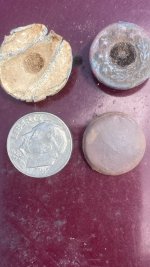gollum
Gold Member
- Jan 2, 2006
- 6,729
- 7,596
- Detector(s) used
- Minelab SD2200D (Modded)/ Whites GMT 24k / Fisher FX-3 / Fisher Gold Bug II / Fisher Gemini / Schiebel MIMID / Falcon MD-20
- Primary Interest:
- All Treasure Hunting
I have a question for everyone;
While the Spanish Trail from Santa Fe to Pueblo de los Angelos (LA) is well documented and mapped, there are several other trails that aren't. I haven't been able to get a single concrete lead on trails through the Joshua Tree Area until the mid 1800's.
Does anybody out there have any maps on file that show trails in this area?
There are several places along the coast of SoCal that were used as staging points for expeditions east. Some of them were fortified, with permanent lookout stations built. One of the best is at the North end of Camp Pendleton.
Thanks-Mike
While the Spanish Trail from Santa Fe to Pueblo de los Angelos (LA) is well documented and mapped, there are several other trails that aren't. I haven't been able to get a single concrete lead on trails through the Joshua Tree Area until the mid 1800's.
Does anybody out there have any maps on file that show trails in this area?
There are several places along the coast of SoCal that were used as staging points for expeditions east. Some of them were fortified, with permanent lookout stations built. One of the best is at the North end of Camp Pendleton.
Thanks-Mike




 I won't say whether or not it is in Joshua Tree Park or not.
I won't say whether or not it is in Joshua Tree Park or not.


